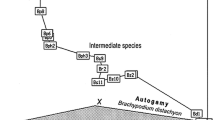Abstract
The carob tree (Ceratonia siliqua L.) is widely used in arid and semi-arid areas of Mediterranean countries for industrial, agricultural and ornamental purposes. We wished to determine the variability of its morphological parameters in relation to its exploitation for commercial purposes. Thirteen cultivated and 15 spontaneous populations of C. siliqua from various edapho-climatic zones of Tunisia were compared to determine the variation in pod and seed parameters, for trees growing in situ, and in 2C nuclear DNA content (determined by flow cytometry), for seedlings grown from seeds collected in situ. Analysis of variance showed significant differences (P < 0.0001) between sites for fresh weight, length, width, internal and external thickness of pods, the pod length/width ratio, percentage of viable seeds and seed fresh weight. The mean pod fresh weights (range 8.63–36.03 g) of cultivated C. siliqua were significantly greater than those of spontaneous trees (7.70–19.39). Similarly, for other morphological characters (pod length, width and thickness and seed weight), the cultivated trees showed the highest mean values: 19.46 cm, 2.22 cm, 0.91 cm and 0.20 g, respectively. How this variability could be exploited for agronomic and commercial purposes is discussed. The variation of the examined morphological characters was not correlated with the quantity of DNA, since there were no significant differences in nuclear DNA content among the cultivated or spontaneous individuals. The mean 2C nuclear DNA content was 1.20–1.30 pg, indicating the trees to be diploid (2n = 24).
Similar content being viewed by others
References
Batlle L, Tous J (1997) Carob tree. Ceratonia siliqua L. Promoting the conservation and use of underutilized and neglected crops. 17. Institute of Plant Genetics and Crop Plant Research, Gatersleben, Germany/International Plant Genetic Resources Institute, Rome, Italy
Bennett MD, Bhandol P, Leitch IJ (2000) Nuclear DNA amounts in angiosperms and their modern uses—807 new estimates. Ann Bot 86:859–909
Bureš P, Pavliček T, Horovã L, Nevo A (2004) Microgeographic genome size differentiation of the Carob tree, Ceratonia siliqua, at ‘Evolution Canyon’, Israel. Ann Bot 93:529–535
Cordell S, Goldstein G, Mueller-Dombois D, Webb D, Vitousek PM (1998) Physiological and morphological variation in Metrosideros polymorpha, a dominant Hawaiian tree species, along an altitudinal gradient: role of phenotypic plasticity. Oecologia 113:188–196
Cummins RP, Miller GR (2002) Altitudinal gradients in seed dynamics of Calluna vulgaris in eastern Scotland. J Veg Sci 13:859–866
Doležel J (1997) Application of flow cytometry for the study of plant genomes. J Appl Genet 38:285–302
Doležel J, Sgorbati S, Lucretti S (1992) Comparison of three DNA fluorochromes for flow cytometric estimation of nuclear DNA content in plants. Physiol Plant 85:625–631
El Shatnawi MKJ, Ereifej KI (2001) Chemical composition and livestock ingestion of carob (Ceratonia siliqua L.) seeds. J Range Manage 54:669–673
Garbgallo MG, Di Lorenzo R, Meli R, Crescimanno G (1997) Characterization of carob germplasm (Ceratonia siliqua L.) in Sicily. J Hortic Sci 72:537–543
Harper JL, Lovell PH, Moore KG (1970) The shapes and sizes of seeds. Annu Rev Evol Syst 1:327–356
Hcini K, Walker DJ, Bouzid S, González E, Frayssinet N, Correal E (2006) Determination of ploidy level and nuclear DNA content in Tunisian populations of Atriplex halimus L. Genet Resour Crop Evol 53:1–5
Hillcoat D, Lewis G, Verdcourt B (1980) A new species of Ceratonia (Leguminosae-Caesalpinoideae) from Arabia and the Somali Republic. Kew Bull 35:261–271
Hultine KR, Marshall JD (2000) Altitude trends in conifer leaf morphology and stable carbon isotope composition. Oecologia 123:32–40
Irwin HS, Barneby RC (1981) Cassieae. In: Polhill RM, Raven PH (eds) Advances in legume systematics, vol 1. Royal Botanic Gardens, Kew, UK, pp 97–106
Khurana E, Singh JS (2001) Ecology of seed and seedling growth for conservation and restoration of tropical dry forest. Environ Conserv 28:39–52
Lo Gullo M, Salleo S (1988) Different strategies of drought resistance in three Mediterranean sclerophyllous trees growing in the same environmental conditions. New Phytol 108:267–276
Makrem A, Ben Fadhel N, Khoudja ML, Boussaid M (2006) Genetic diversity in Tunisian Ceratonia siliqua (Caesalpinioideae) natural populations. Genet Resour Crop Evol 53:1501–1511
Marshall DL, Levin A, Flower NL (1986) Plasticity of yield components in response to stress in Sesbania macrocarpa and Sesbania vesicaria (Leguminosae). Am Nat 127:508–521
Pluess AR, Schütz W, Stöcklin J (2005) Seed weight increases with altitude in the Swiss Alps between related species but not among populations of individual species. Oecologia 144:55–61
Price HJ, Chambers KL, Bachman K, Riggs J (1986) Patterns of mean nuclear DNA content in Microseris douglasii (Asteraceae). Bot Gaz 147:496–507
Qiang W, Wang XL, Chen T, Feng HY, An LS, He YQ, Wang G (2003) Variation in stomatal density and carbon isotope values in Picea crassifolia at different altitudes in Qilian Mountains. Trees 17:258–262
Russo G, Andrea LD (2000) Evaluation and Preservation of Genetic Resources of Carob (Ceratonia siliqua L.) in Southern Italy for Pharmaceutical use. J Herb Spices Med Plant 9:367–372
Russo G, Polignano GB (1996) Variation of seed and fruit characters in Ceratonia siliqua L. cultivars. Genet Resour Crop Evol 43:525–531
Smith CC, Fretwell SD (1974) The optimal balance between the size and number of offspring. Am Nat 108:499–506
Sparks JP, Ehleringer JR (1997) Leaf carbon isotope discrimination and nitrogen content of riparian trees along an elevational gradient. Oecologia 109:362–367
Stephenson AG (1984) The regulation of maternal investment in an indeterminate flowering plant (Lotus corniculatus). Ecology 65:113–121
Tous J, Olarte C, Truco MJ, Ars P (1992) Isozyme polymorphisms in carob cultivars. Hortscience 27:257–258
Tucker SC (1992a) The developmental basis for sexual expression in Ceratonia siliqua (Leguminosae: Caesalpinioideae: Cassieae). Am J Bot 79:318–327
Tucker SC (1992b) The role of floral development in studies of legume evolution. Can J Bot 70:692–700
Turpeinen T, Kulmala J, Nevo E (1999) Genome size variation in Hordeum spontaneum populations. Genome 42:1094–1099
Walker DJ, Moñino I, González E, Frayssinet N, Correal E (2005) Determination of ploidy and nuclear DNA content in populations of Atriplex halimus (Chenopodiaceae). Bot J Linn Soc 147:441–448
Westoby M, Jurado E, Leishman M (1992) Comparative evolutionary ecology of seed size. Trends Ecol Evol 7:368–372
Westoby M, Leishman M, Lord J (1997) Comparative ecology of seed size and dispersal. In: Silvertown J, Franco M, Harper JL (eds) Plant life histories—ecology phylogeny and evolution. Cambridge University Press, Cambridge, pp 143–162
Zohary M (1973) Geobotanical foundations of the middle east. Fisher, Stuttgart, Germany
Acknowledgements
This work was funded by the Institut National de Recherche en Génie Rural Eaux et Forêts (Tunisia) and by the Consejería de Agricultua y Agua de la Región de Murcia (Spain).
Author information
Authors and Affiliations
Corresponding author
Rights and permissions
About this article
Cite this article
El Ferchichi Ouarda, H., Naghmouchi, S., Walker, D.J. et al. Variability in the pod and seed parameters and nuclear DNA content of Tunisian populations of Ceratonia siliqua L.. Agroforest Syst 74, 73–81 (2008). https://doi.org/10.1007/s10457-008-9135-4
Received:
Accepted:
Published:
Issue Date:
DOI: https://doi.org/10.1007/s10457-008-9135-4




